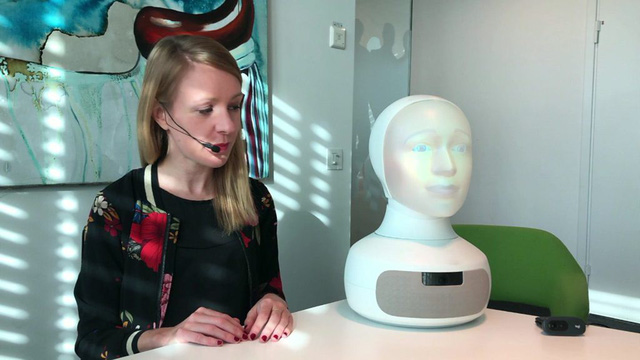To reporters are also at risk of unemployment with the latest invention!
- Tram Ho
Written by K Nguyen
Tengai is the first robot in the world designed to conduct neutral, unbiased interviews and is being tested by employers in Sweden. But can it really accomplish this task better than humans?
Tengai weighed 3.5 kg and was 41 cm tall, at eye level with the candidate he interviewed. Tengai is the brainchild of Furhat Robotics, an artificial intelligence company (AI) and social robot company founded after a research project of the KTH Royal Institute of Technology in Stockholm.
The company spent four years building a human-like computer interface, mimicking our communication and facial expressions. According to the scientific director of Furhat Robotics, their idea is to create a robot that is less scary or strange than traditional robots.
Since October 2018, this start-up has partnered with one of Sweden’s largest recruitment companies, TNG with the aim of helping applicants to undergo job interviews without receiving any unconscious prejudice in the recruitment process while still giving the impression of talking to real people.
Elin Öberg Mårtenzon, innovation director at TNG’s office in Stockholm, explains: “Normally, it takes about 7 seconds for someone to make a first impression and about 5-15 minutes for an employer to make a decision determined. We want to challenge that. ”
Unconscious biases include assumptions about someone’s ability to rely on gender, ethnicity, voice, education, appearance or impression from informal conversations before or after an interview. .
In contrast, Tengai did not participate in pre-interview conversations and posed all the same questions, using the same intonation and common sense, in the same order. This makes an interview more fair and objective.
Employers or managers then receive copies of each interview to help them decide which candidates will continue to enter the round, based solely on their answers.
Petra Elisson, an employer in the health care industry, said: “I think that there is someone, a robot without emotion, that doesn’t feel like a very helpful aid in the screening process. – if you have a recruitment process with a lot of candidates. ”
She participated in the Tengai testing process as an employer analyzing the candidates’ answers and being an interviewee. Elisson was very surprised after the interview with Tengai, she had completely forgotten it was just a robot.
However, robots are programmed by humans, analyzing human-programmed data sets and learning from human behavior, are they affected by human prejudice?
Furhat Robotics said it has found a way to prevent this by conducting many experimental interviews with a diverse group of volunteers. Gabriel Skantze, a start-up scientist, said that thanks to learning from many different employers, Tengai will not mimic the specific behavior of a certain employer.

After a few months of testing, Tengai will start interviewing real candidates at the end of May. Employers and developers are also studying an English version of Tengai, expected to be released in early 2020.
The ultimate goal is robots like Tengai will be sophisticated enough to decide whether a candidate can pass the interview round, without the need for humans to read the recorded transcript. Mr. Skantze said that in order to do this, his company needed to ensure that there was no bias in their data.
Sweden seems to be an interesting testing environment for recruitment by AI. Aside from being a small and famous country by adopting new technology very early, ethnic diversity in the labor market is a particularly hot topic after record immigrants in Sweden in recent years. here.
The unemployment rate of indigenous people is about 4%, but citizens born abroad, the number of days exceeds 15%. A recent survey for TNG shows that 73% of job seekers in Sweden believe that they are discriminated against when applying for jobs based on race, age, gender, sexual orientation, appearance.
Robots like Tengai can be a great first step in the process of making the recruitment process more objective, since they do not have any prejudices about dialect or voice and ethnicity.
According to the Economic Life Cycle
